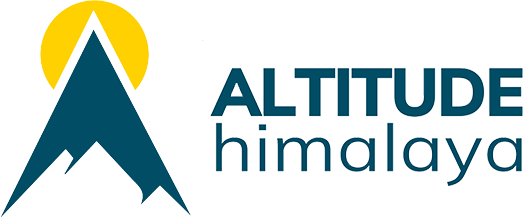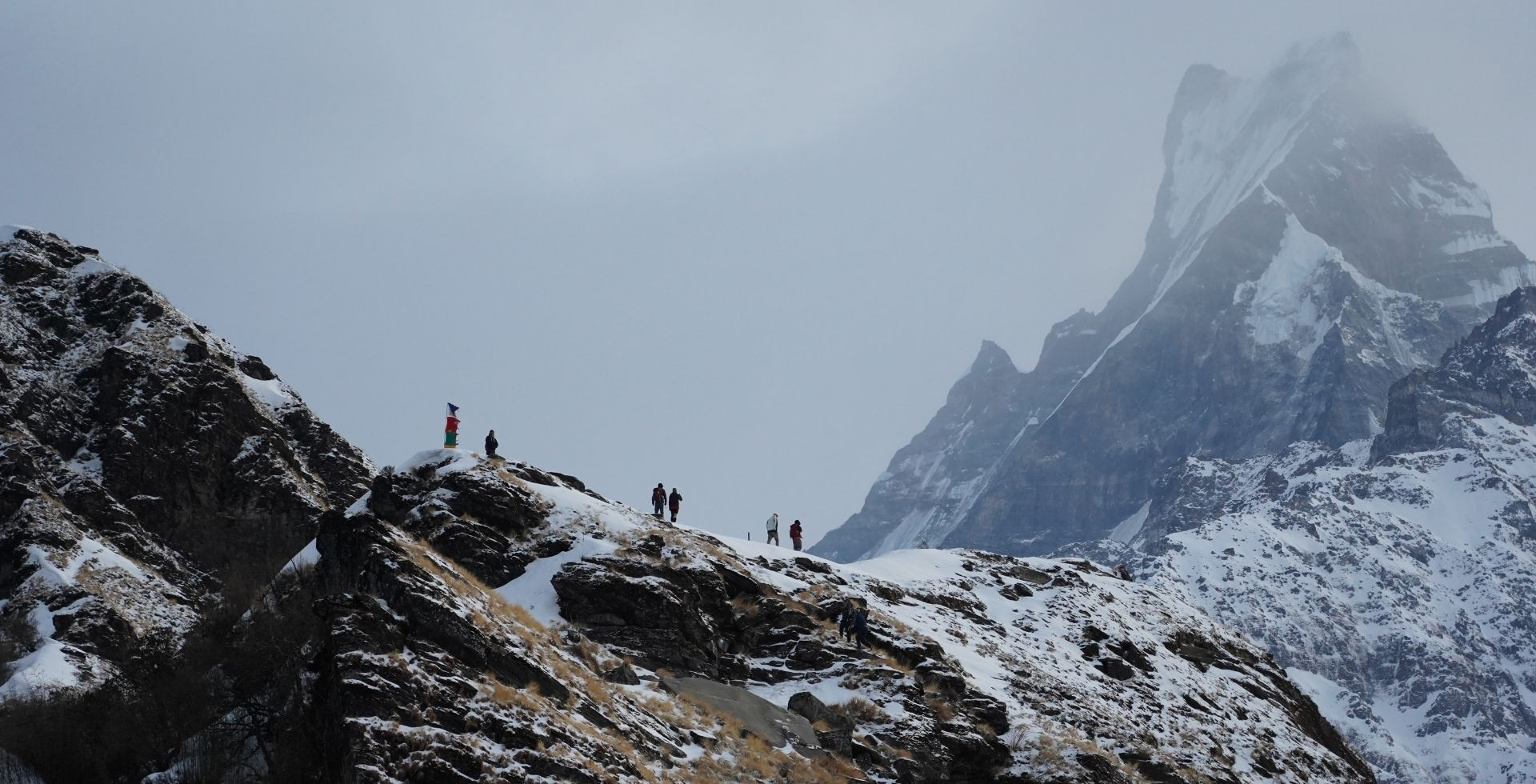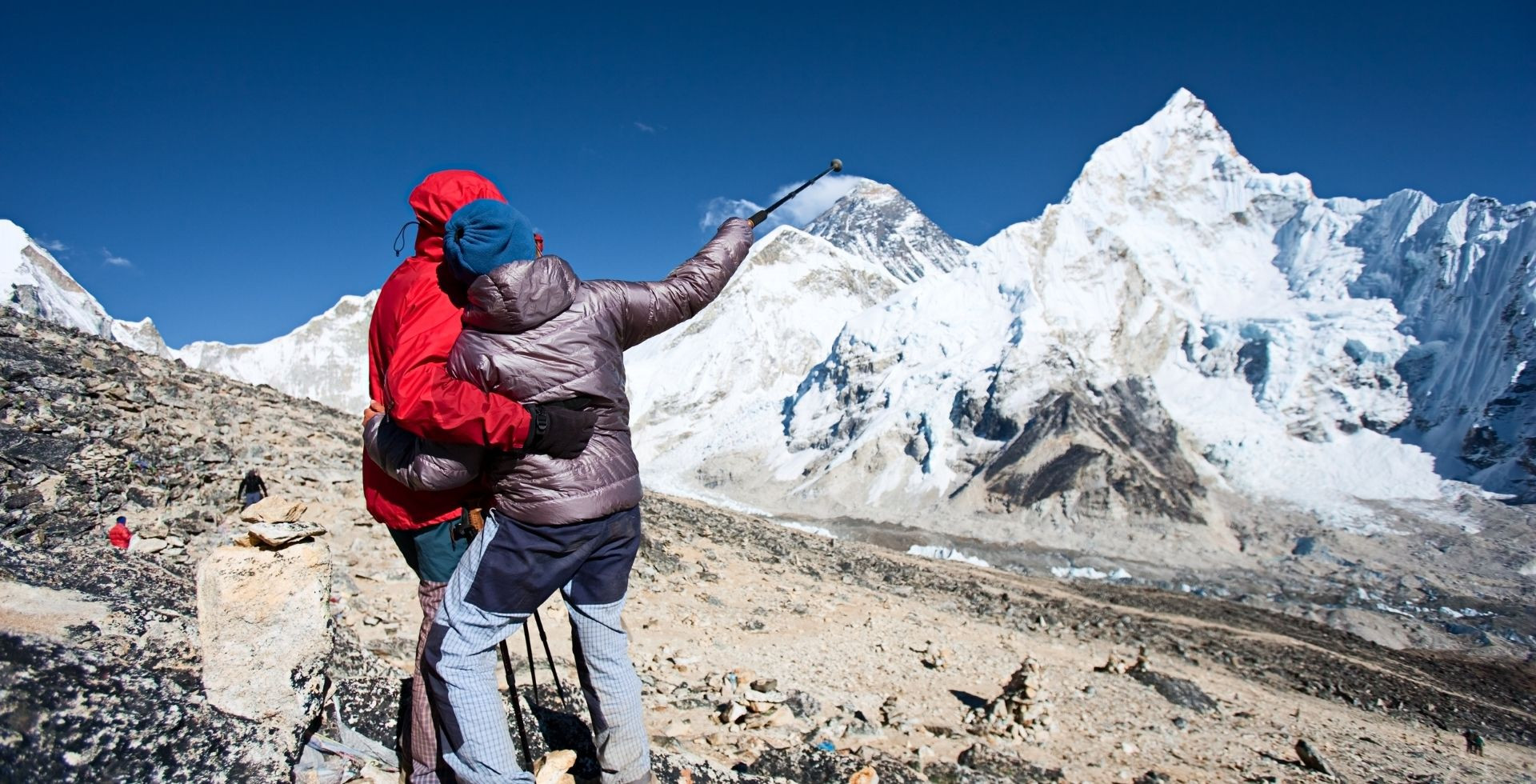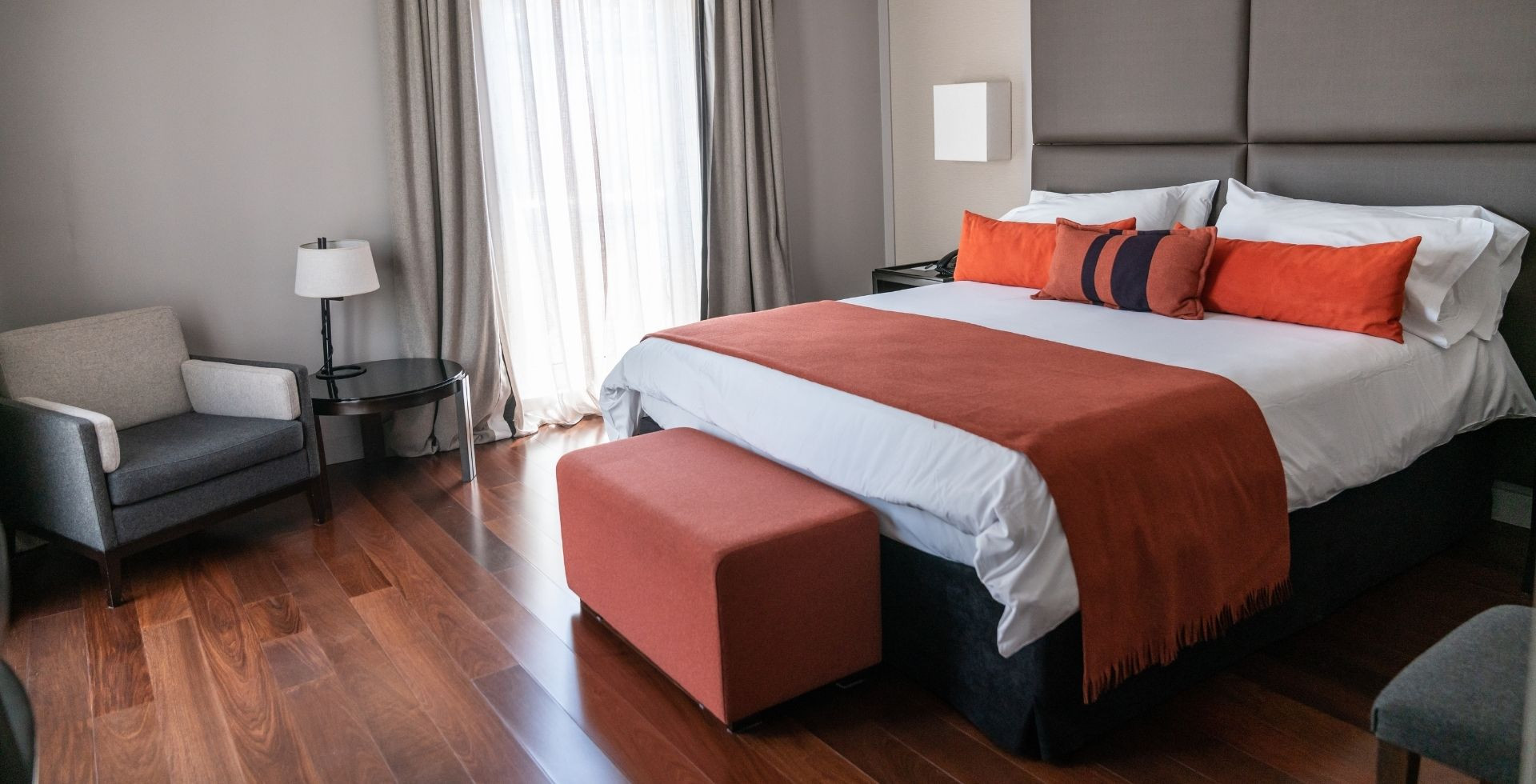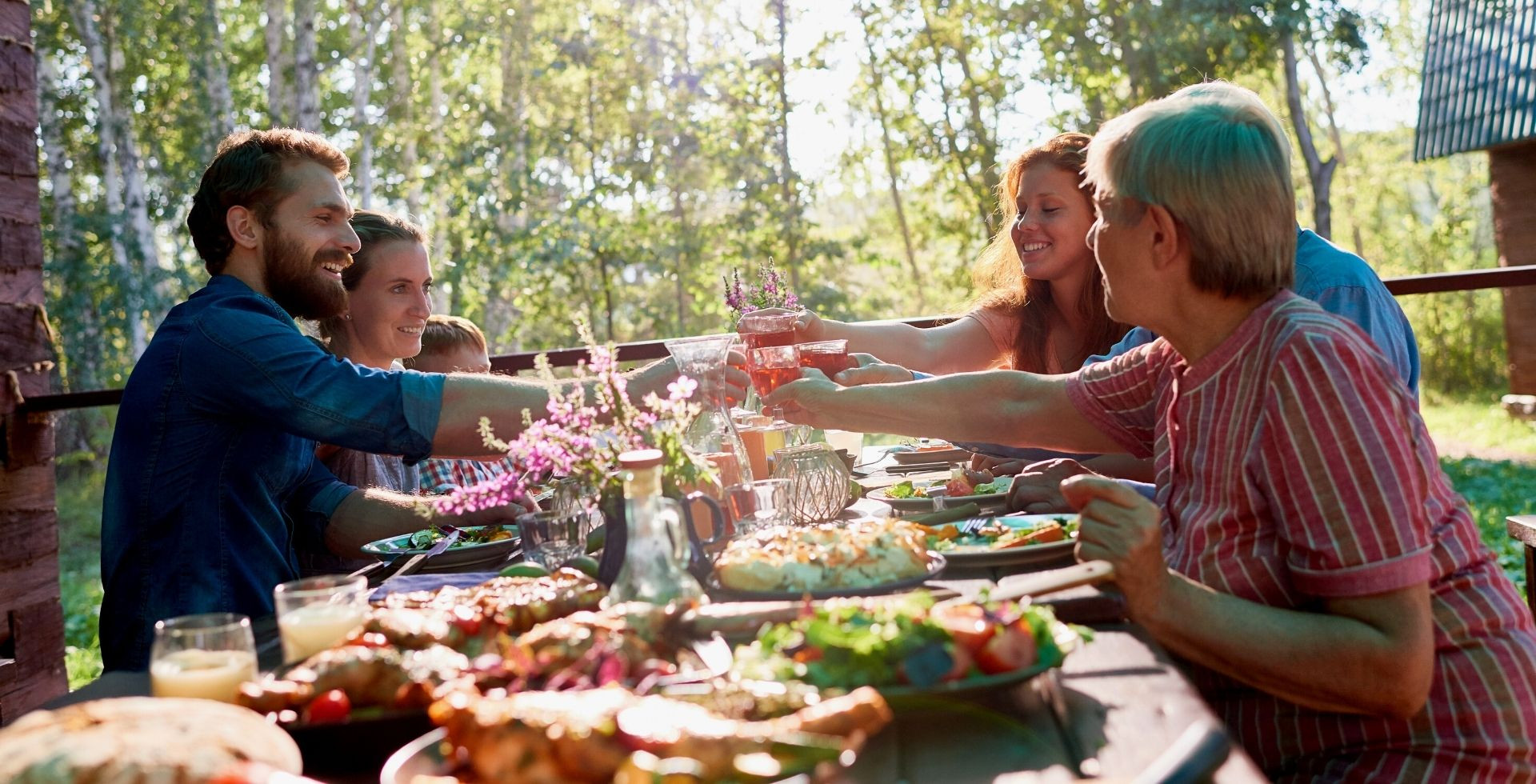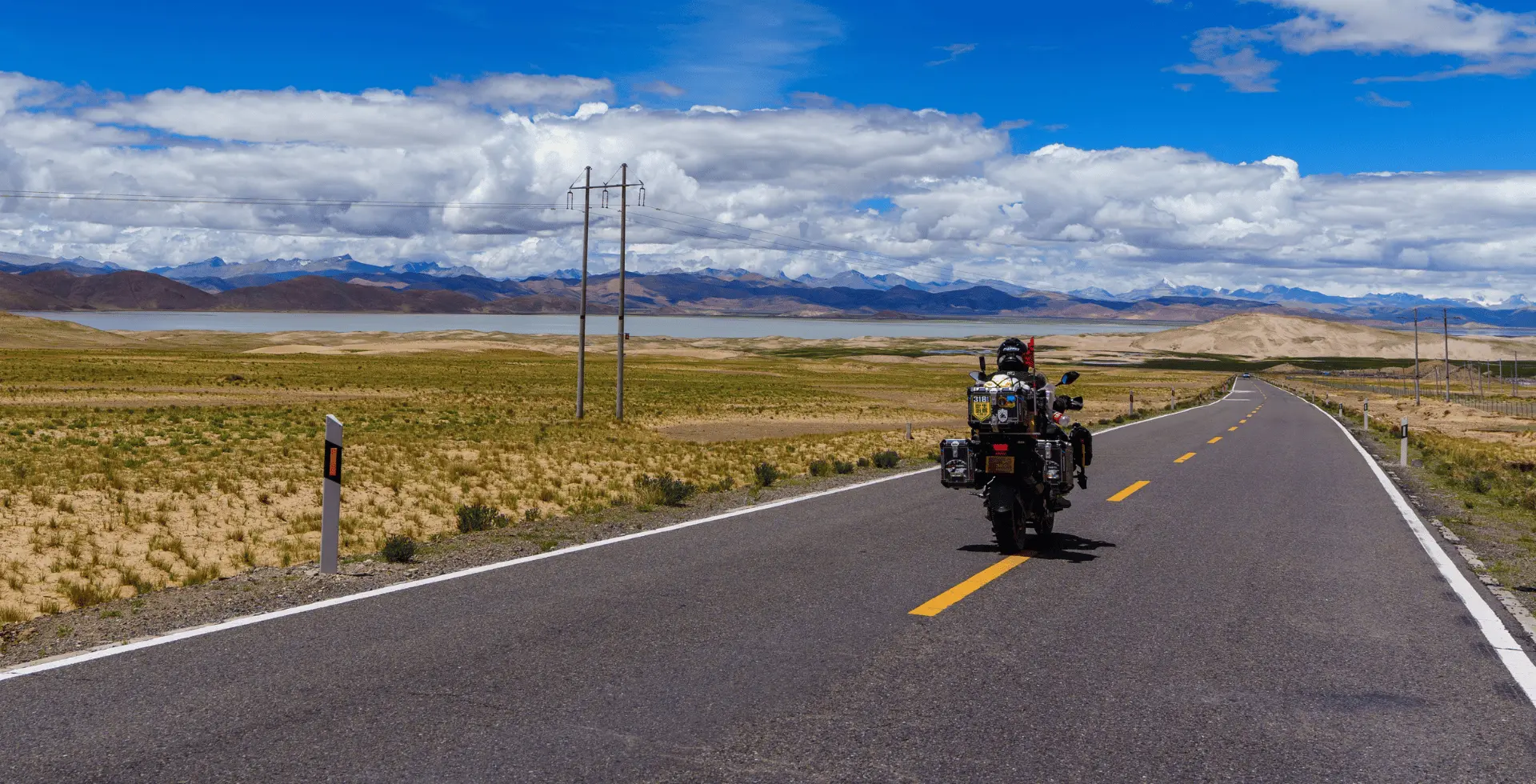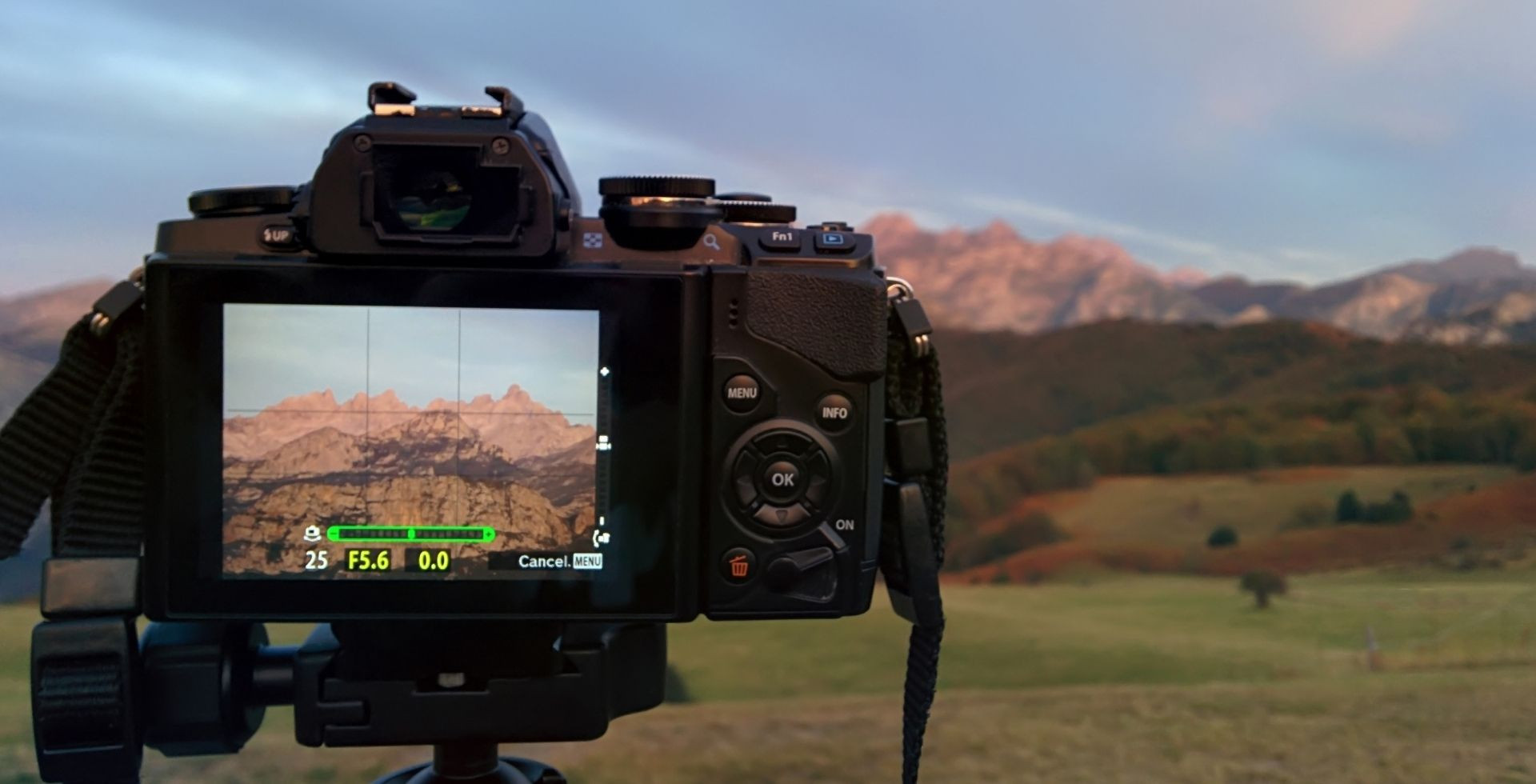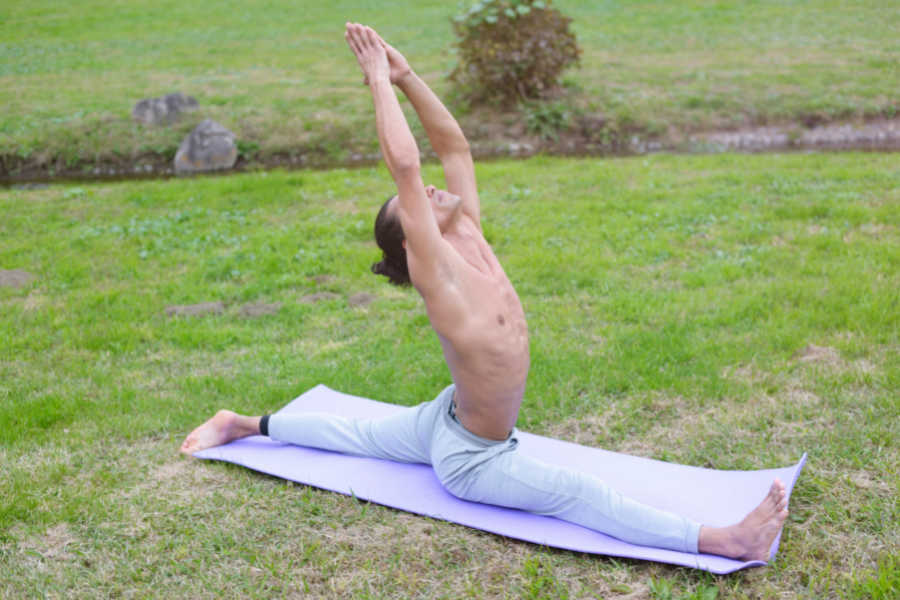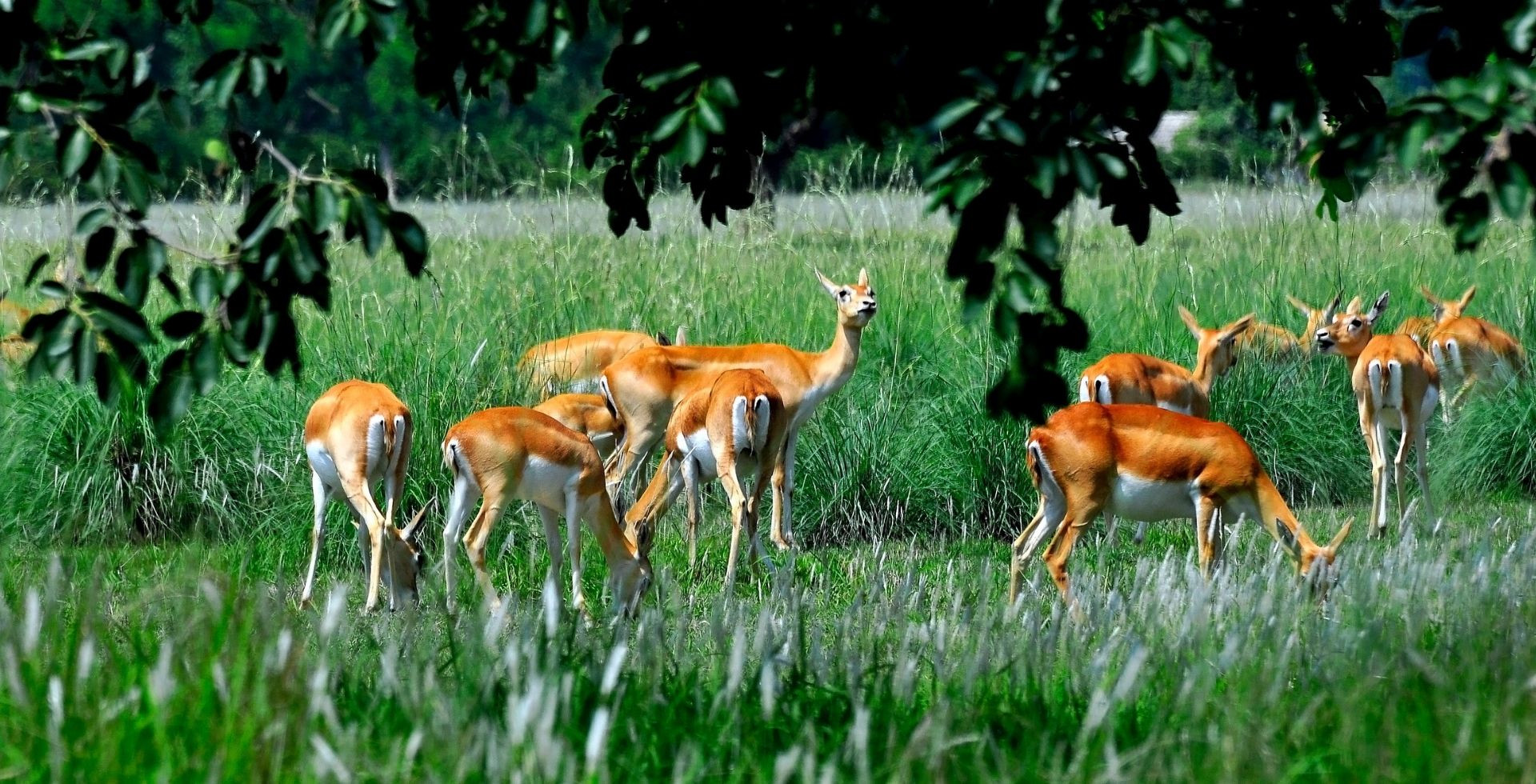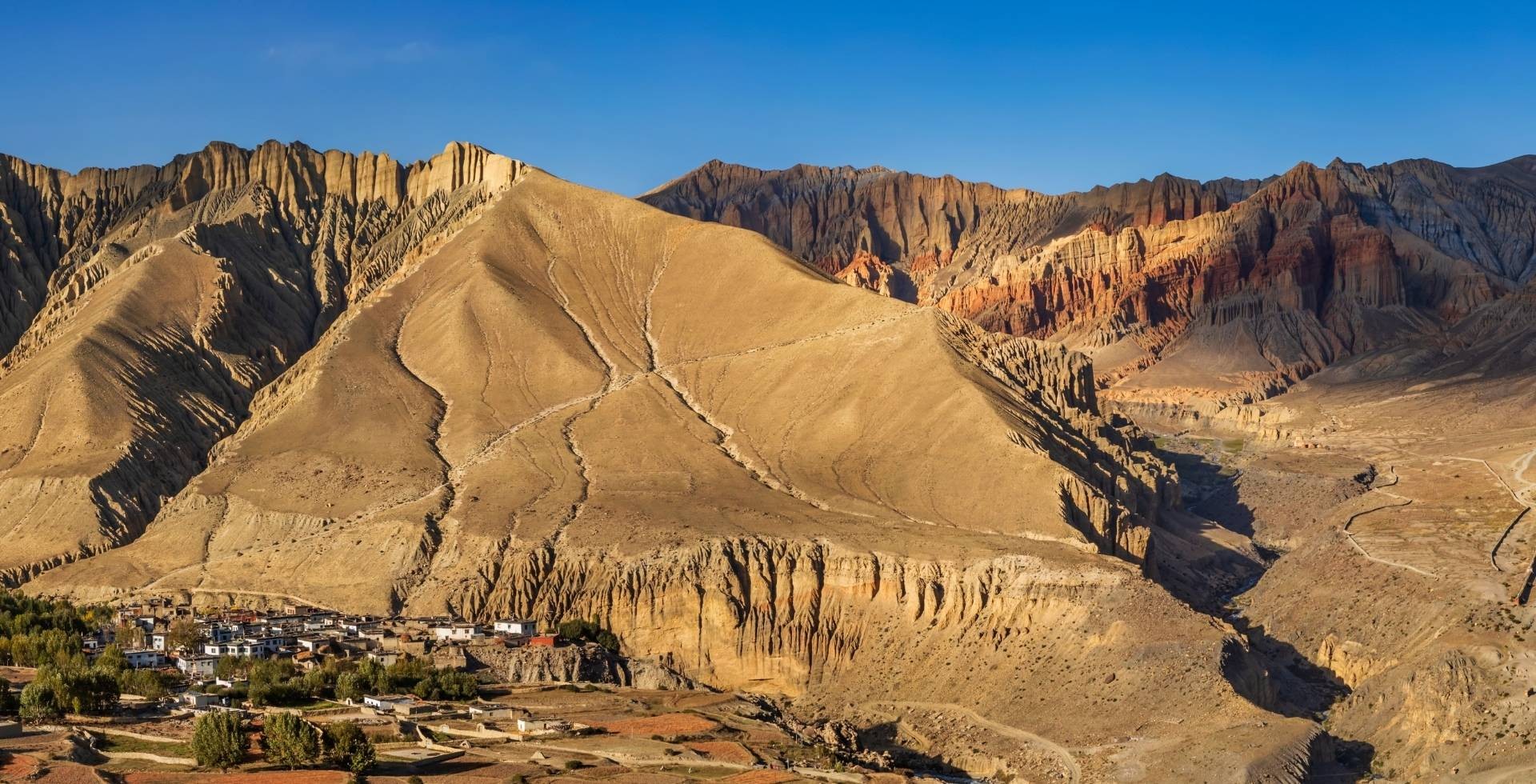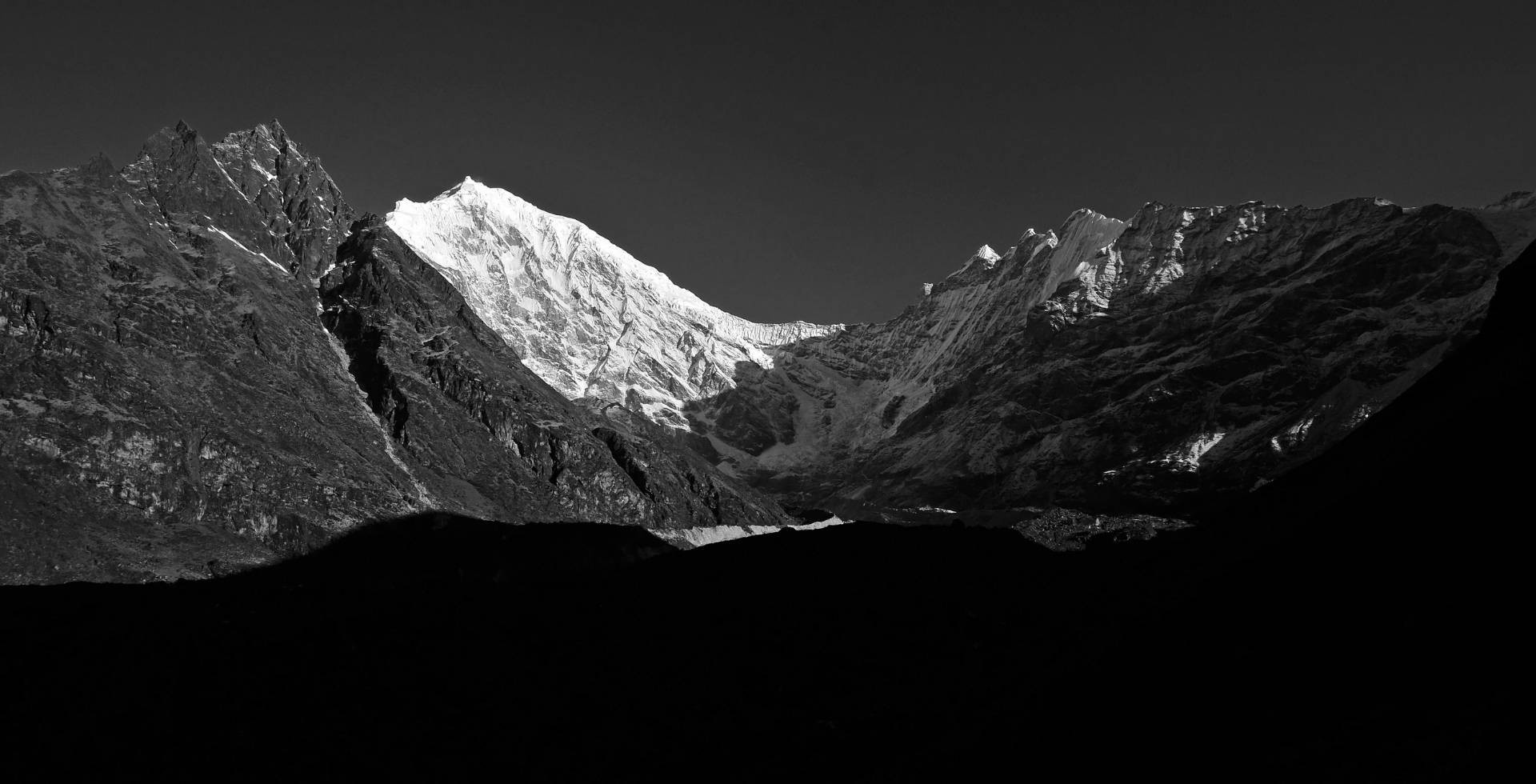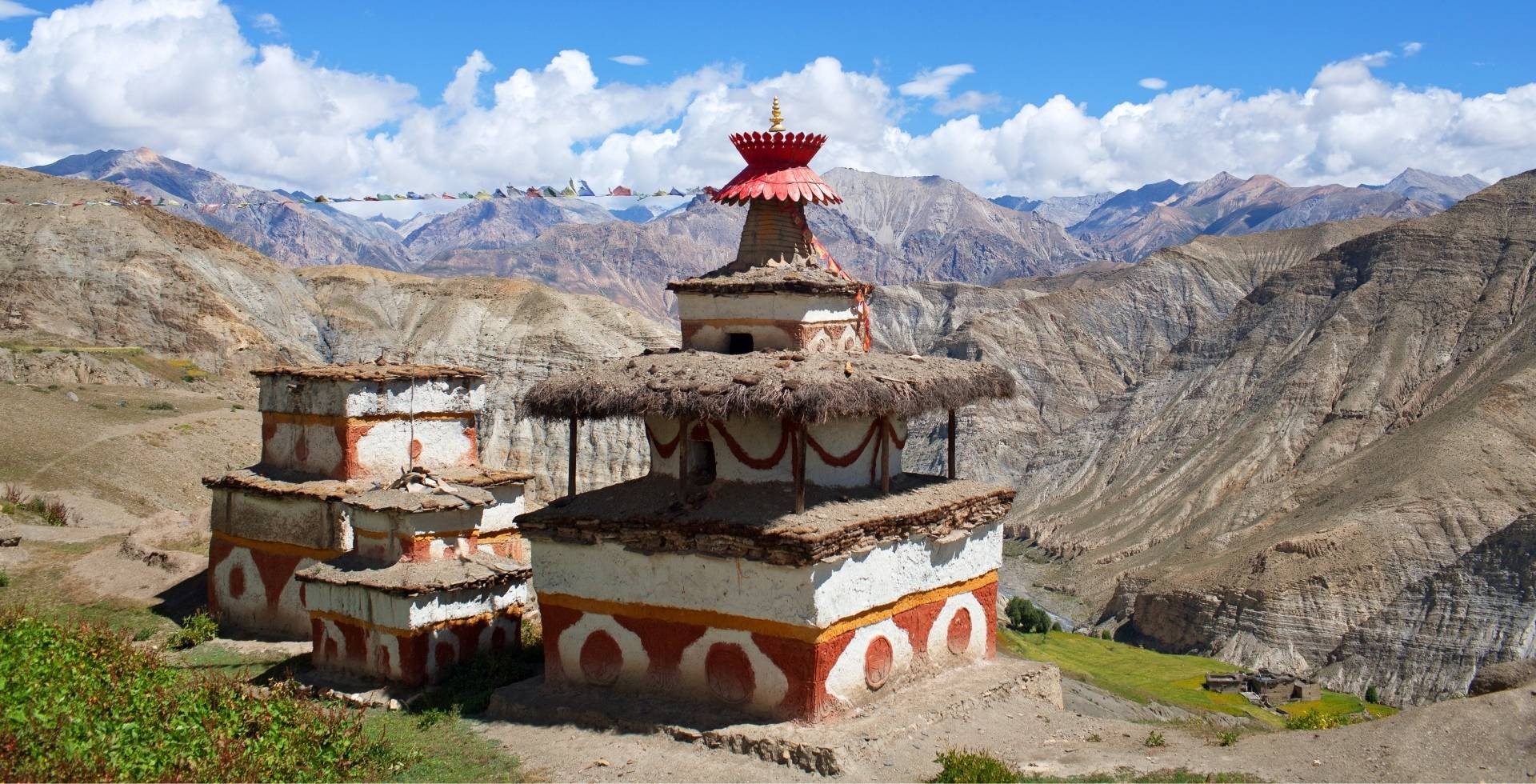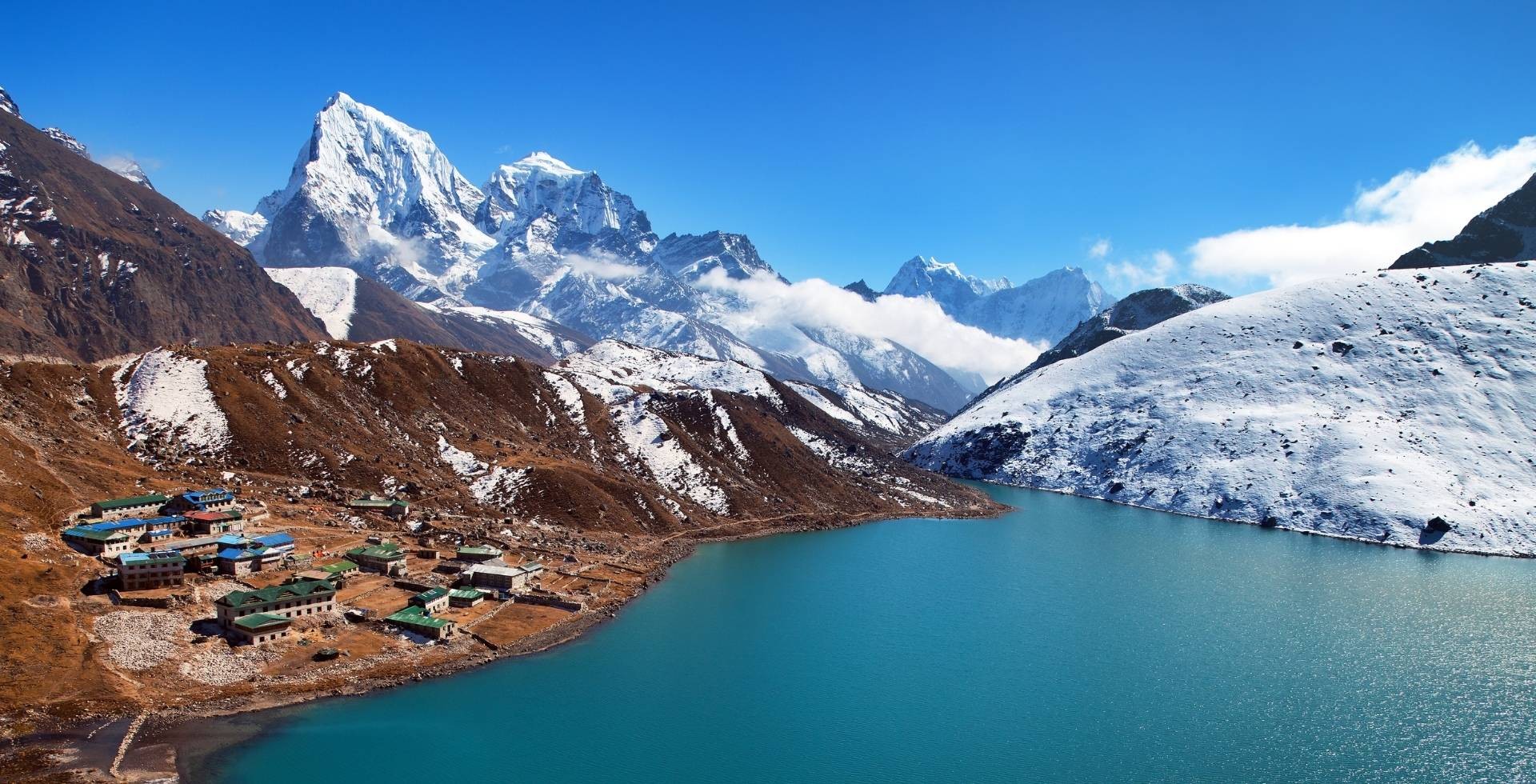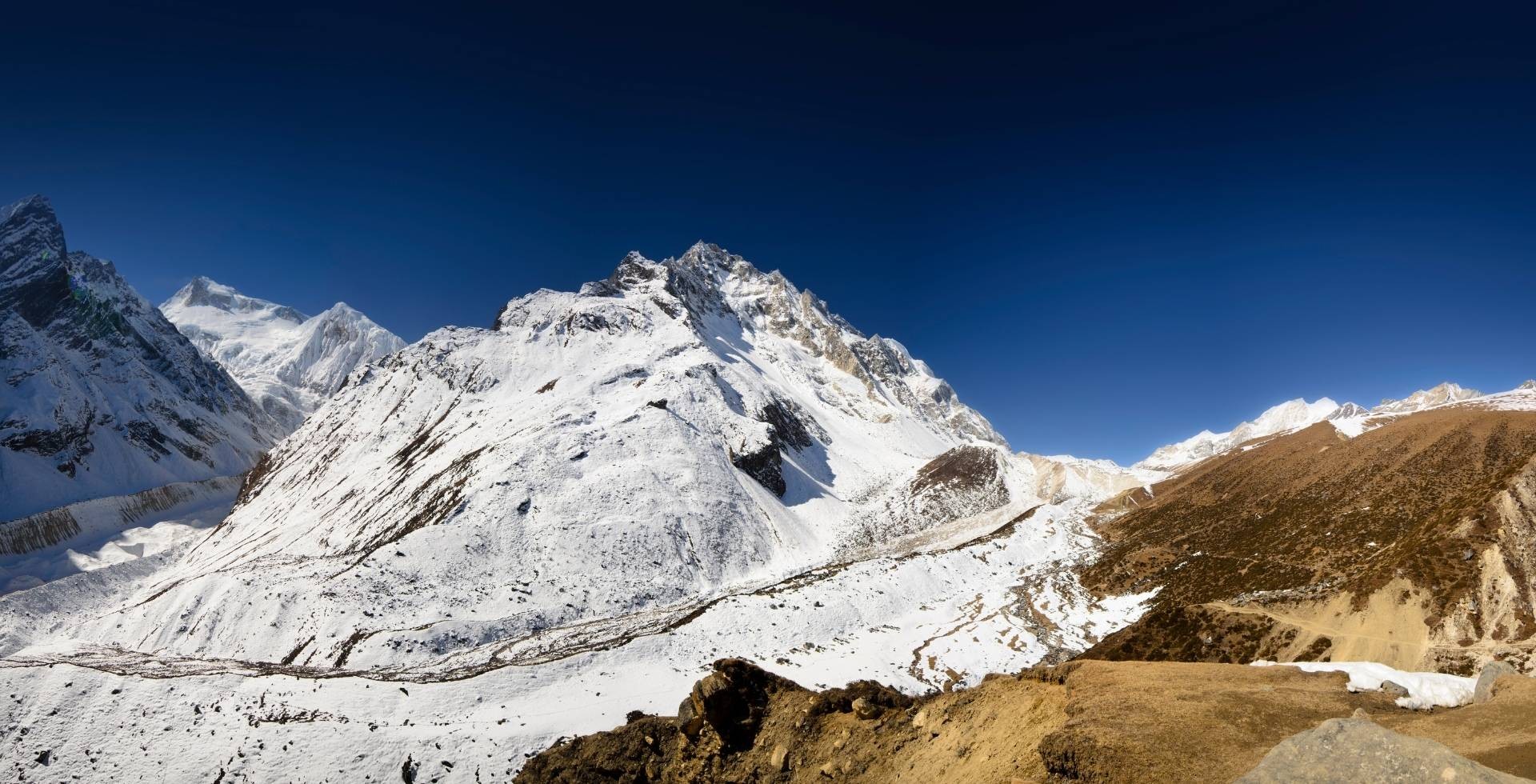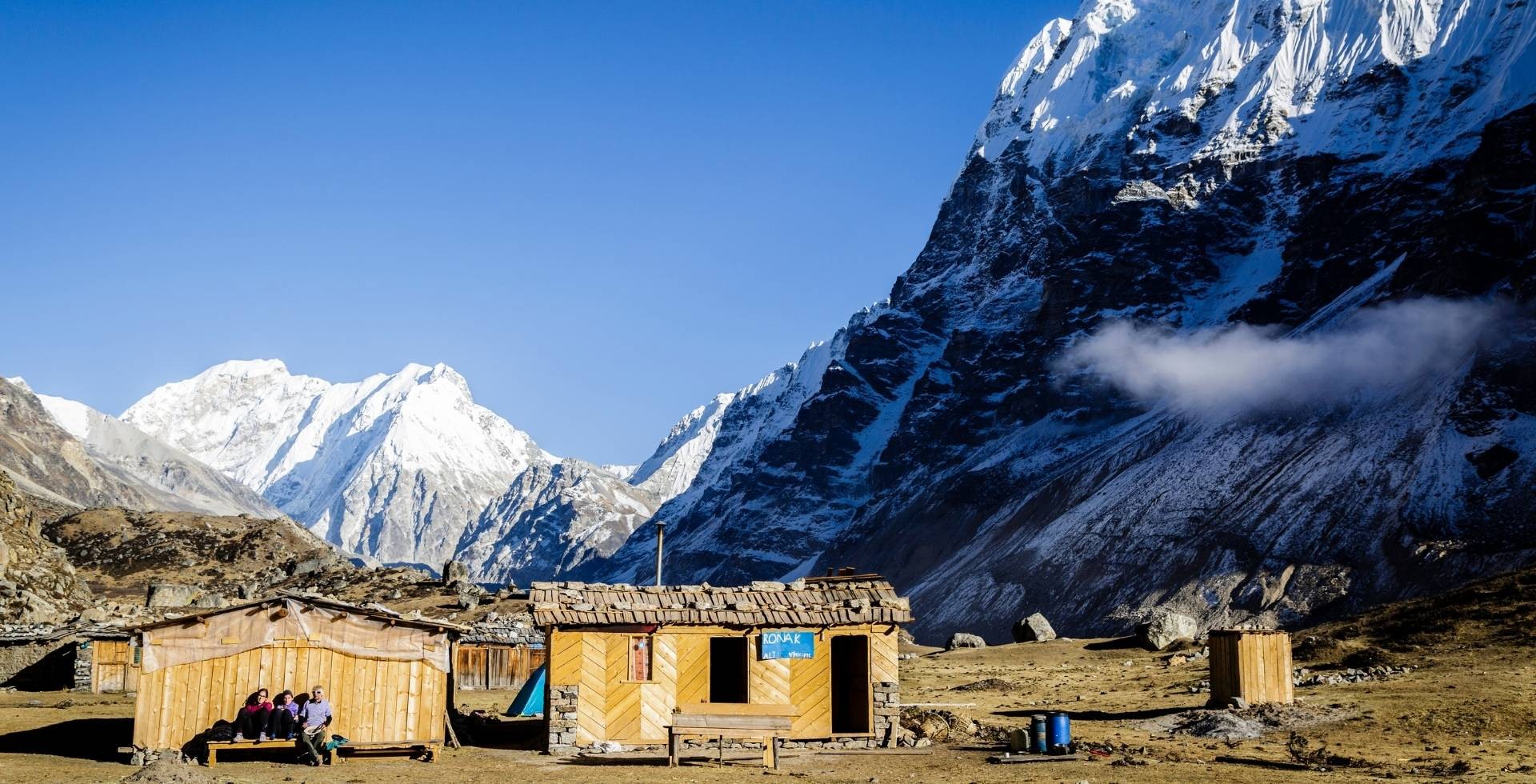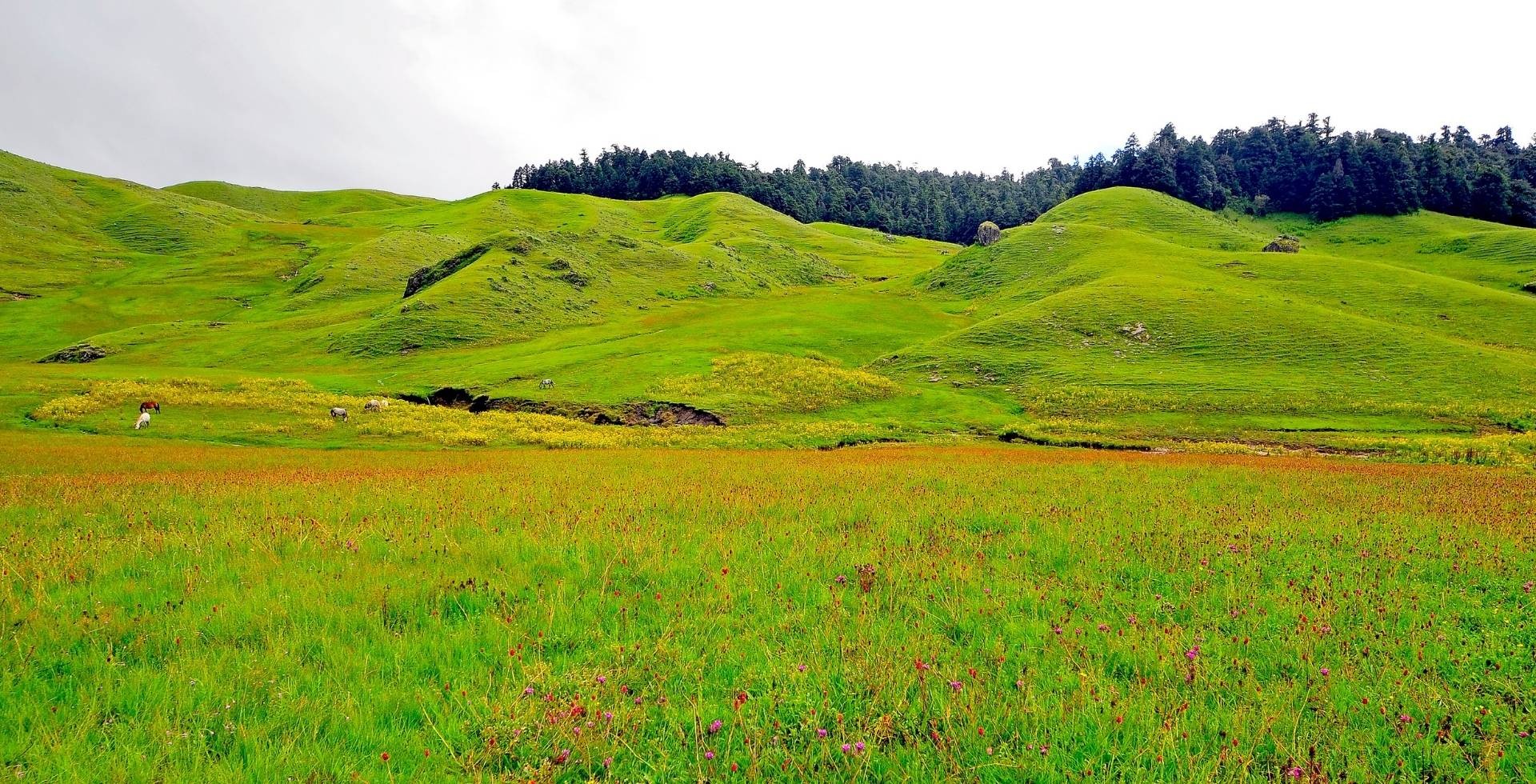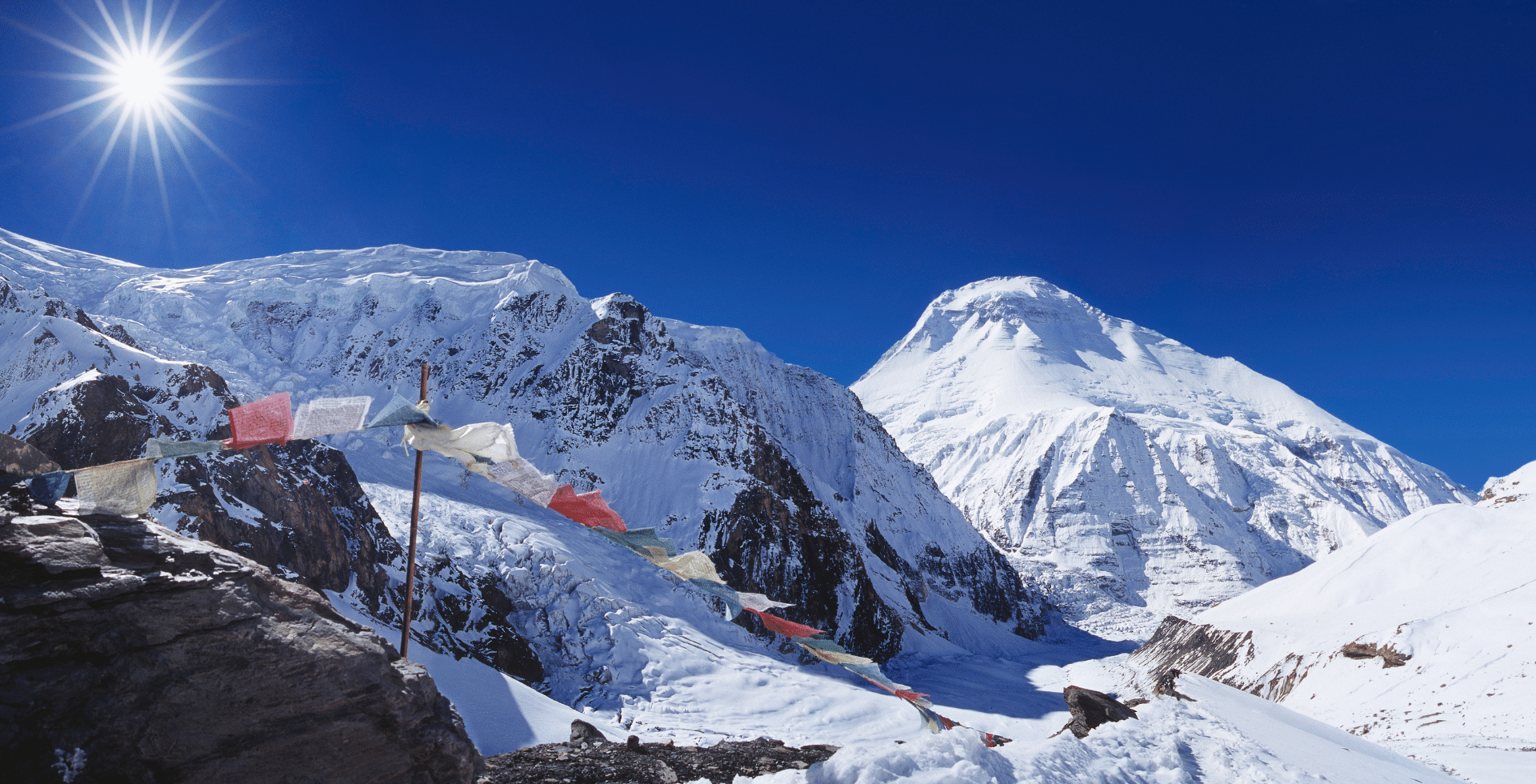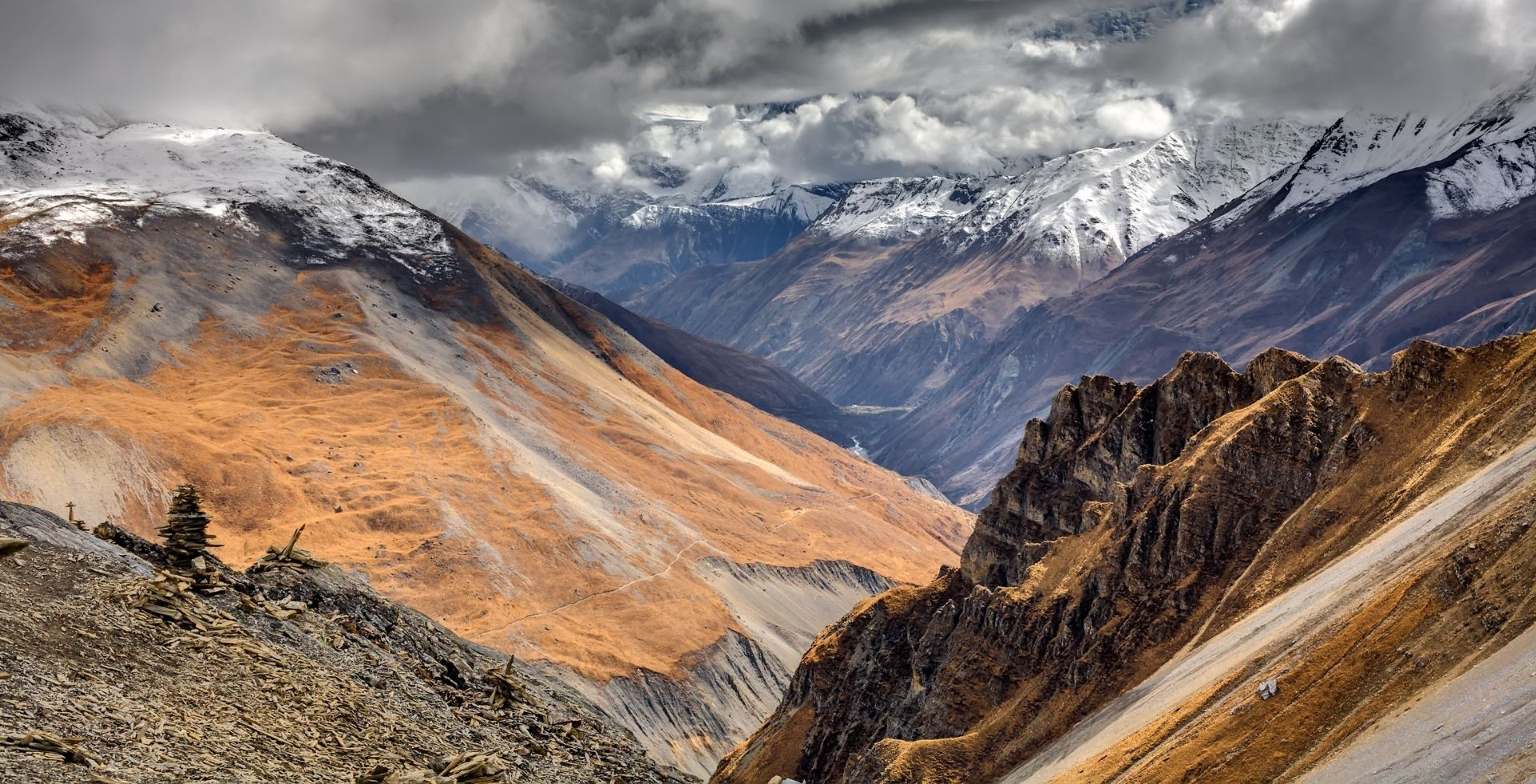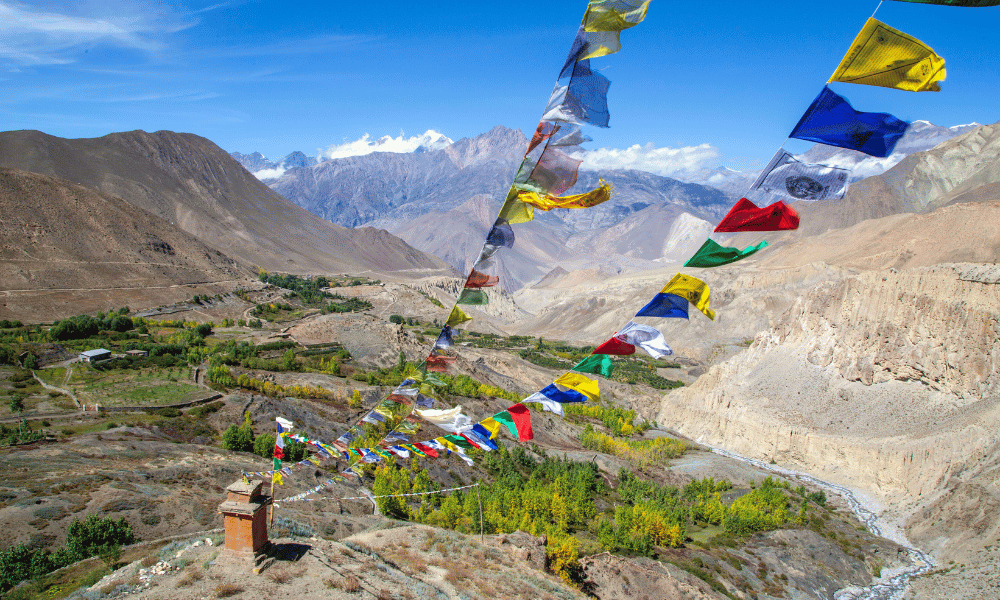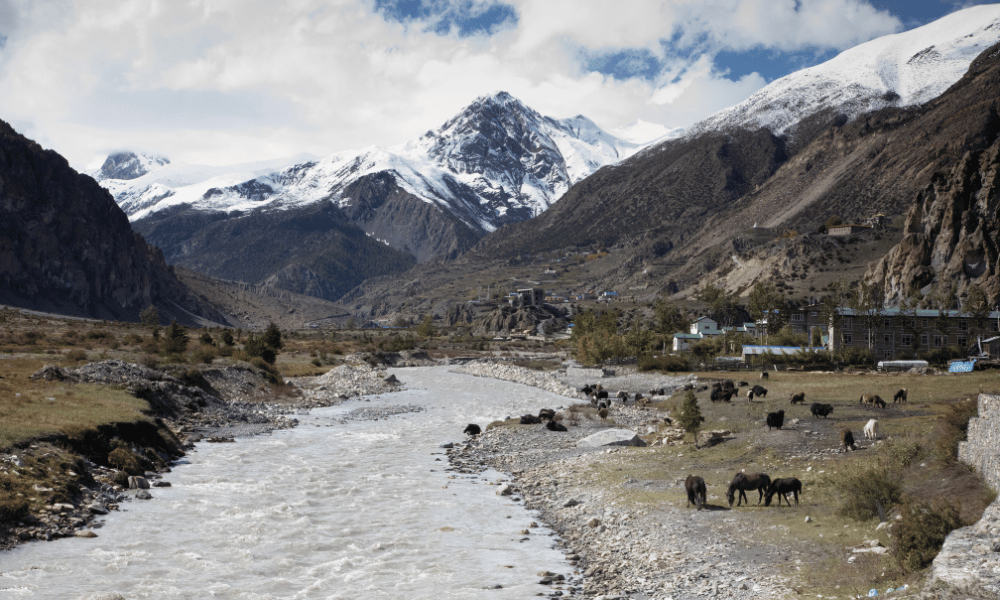The Annapurna Conservation Area (ACA) is Nepal’s largest protected region, covering nearly 7,600 square kilometers in the western region. It’s even home to some of the world’s highest peaks (Mt. Annapurna, of course, is the main one), deep river valleys, alpine forests, ancient villages, and perhaps one of the most biologically diverse zones in the country!
Talking about the Annapurna Circuit, it is a legendary trail that circumnavigates the Annapurna massif. For decades, this trail has drawn trekkers from all over the world, and it’s your turn to experience it.
Well, the region is full of surprises. But here’s the thing: you don’t have to walk it, all thanks to our package from Altitude Himalaya. You’ll be going on this adventure on a mountain bike.
Mountain biking on this trail is a different kind of thrill. You get the same breathtaking scenery that trekkers get, the same diverse landscapes, and cultural depth, too. What’s unique is that it comes with more adrenaline, more movement, and more challenge.
You'll ride through the Marsyangdi valley, push your bike up to Thorong La Pass at 5,416 m, and cruise down into the Kali Gandaki gorge, which is the world’s deepest too!
At Altitude Himalaya, we neither sugarcoat things nor oversell comfort. What matters to us is your wonderful experience. And since we’ve done this ride ourselves, tested the trail, mapped the terrain, met the locals, and stayed in those same teahouses we’ll take you to, there’s this advantage of the ‘expertise’ factor that makes us unique from others.
We’ve indeed handpicked every route and timing based on our real experiences, not just using Google Maps or GPS.
Our guides aren’t just trail leaders, they’re storytellers, mechanics, motivators, and part-time photographers when your hands are too cold to shoot (so much in one package, right?). And most importantly, we respect the places we go through, and we make sure you experience this journey the way it deserves to be.
This 15-day Annapurna Circuit Mountain Biking tour kicks off in Kathmandu for a proper warm-up ride through the offbeat trails of Patan, Godawari, and Lakuri Bhanjyang, eventually reaching Bhaktapur and Pashupatinath.
The next day, we drive you to Besisahar, the starting point of the biking trail. And your real ride starts after one night of staying there as you pass through riverside villages like Khudi, Ngadi, and Syange, stopping at waterfalls, crossing countless suspension bridges, and climbing all the way up to the heart of Manang after staying a night in Chyamche.
We’ll acclimatize, rest, and then go for the big one that we’ve been emphasizing all along: THE THORONG LA PASS. After that, your mountain biking in Nepal goes downhill through the spiritual Muktinath, then towards Mustang’s Kagbeni and the alleys of Marpha, finally heading into Tatopani for a dip in the hot springs.
You’ll also pass via Dhumba Lake and Titi Lake near Jomsom (which are optional trips). The final leg of this tour leads to Beni and onto a private jeep to Pokhara, where we’ll wrap up with two leisure days.
Excited already? Well, we are to serve you! But before that, go through this package thoroughly before hitting that ‘Book Now’ button.
Annapurna Circuit Mountain Biking Facts
Here are some facts about this Mountain biking tour:
|
Region |
Annapurna Conservation Area |
|
Highest Elevation |
5,416m at Thorong La Pass |
|
Total Biking Distance |
270 to 280 km approx. |
|
Avg. biking distance per day |
30 to 45 km |
|
Permits Required |
Annapurna Conservation Area Permit (ACAP) Trekkers’ Information Management System (TIMS) |
|
Ethnic Groups |
Tamang, Magar, Gurung, Brahmin, Chhetri, Damai, Kami, Sarki, Majhi, Manangi, Lama, Ghale, Bhote, Thakali |
|
Route |
Besisahar > Chyamche > Chame > Manang > Thorang Phedi > Thorang La Pass > Muktinath > Kagbeni > Jomsom > Marpha > Tatopani > Beni |
Major Landmarks Along the Mountain Biking Tour
Mountain biking along the trails of the legendary Annapurna Circuit is not just about the landscapes that change, but you even meet people, cultures, and hear stories that shift with every climb and every descent.
From visiting historic trading towns and exploring quiet Himalayan villages to praying in sacred temples and enjoying local products, this 15-day tour brings you face-to-face with the real Nepal!
Below, we’ve highlighted the key places that make this journey unforgettable. Continue reading as we’ll explore every village, valley, and pass digitally before you even book your trip to this small nation.
Kathmandu: The Capital City
Kathmandu city is the cultural and spiritual heart of the country, which is why it’s one of the best capitals in the world. For this Annapurna Circuit Mountain Biking Tour, Kathmandu valley becomes your first step!
But we’re not taking you for a regular sightseeing route. We’re not heading into museums or experiencing the culture in-depth. Instead, this part of the trip gives you an off-the-beaten-path cycling experience through all three districts of the Kathmandu Valley: Lalitpur, Bhaktapur, and Kathmandu.
We begin the warm-up ride from Patan Durbar Square, a place filled with historic architecture. From here, we slowly climb toward Lakuri Bhanjyang via Godawari, skipping popular stops like the museum or botanical garden and focusing solely on the trail experience. It’s a scenic route that starts to work your legs and lungs.
After reaching Lakuri, we descend through the forested trail toward Suryabinayak via Gundu, a route that's quiet and green. Eventually, the ride brings us to the ancient streets of Bhaktapur Durbar Square, where you’ll ride past red brick courtyards, temples, and hidden alleys.
And before the day ends, we follow an inner route back to Kathmandu, reaching the sacred Pashupatinath Temple. If time allows and you still have that energy, you can witness the Sandhya Arati, an evening ritual performed right by the Bagmati River. You can pray for your safe mountain biking trip during the program!
Besisahar: District Headquarters of Lamjung
Besisahar lies in the mid-hills of western Nepal and serves as the district headquarters of Lamjung. It’s a culturally rich region located between the lowlands and the high Himalayas. Even its name “Besisahar” comes from two words: ‘Besi’ meaning lowland and ‘Sahar’ meaning town.
Historically, Besisahar had been a significant meeting point for people from the hills and the plains. Today, it stands as the gateway to the Annapurna Conservation Area and, more importantly, as the official starting point of our Annapurna Circuit Mountain Biking Tour.
To reach Besisahar, you’ll drive about 175 kilometers west from Kathmandu, a journey that takes roughly 7 hours in a private vehicle. The road takes you through the districts of Dhading, Chitwan, and Tanahun before finally entering Lamjung.
Besisahar is home to a mix of Gurung, Magar, Brahmin, and Chhetri communities. Most notably, the people here are Gurungs, who are known for their unique local traditions.
Chyamche: Gateway to the Marsyangdi Gorge
Chyamche is a peaceful stone village located at about 1,400 m on the edge of the Marsyangdi River. You’ll reach here passing via Khudi Bazaar, Ngadi, Syange, and Jagat.
From here, the air begins to feel cooler, which is a clear indication that you’re very close to the mountains. The local population is a mix of Gurung, Magar, and Damai families here. Also, some Majhi (river-fisher folks) live closer to the riverbanks. You get to experience a very different set of customs and traditions than other parts of Nepal. You even get to enjoy Gurung rodhi songs in the evenings and witness Majhi-made wooden river crafts and fishing gear.
Not to forget that the place is buzzing with honey-hunting stories, as it’s quite a popular activity in Lamjung. Moreover, travellers share tips that shall help you get the insights of their experiences when traversing from low hills to high passes. So, listen carefully!
Chame: District Headquarters of Manang
Chame, located at around 2,670 m, serves as the administrative heart of Manang District. You’ll reach here after passing the tiny villages of Tal, Dharapani, Bagarchhap, Thanchok, and Timang.
Just like Chyamche, it’s somewhere along the Marsyangdi River, making it a naturally scenic stop on the Annapurna Circuit Mountain Bike Tour.
Chame hosts mainly Gurung and Manangi Tibetan-descended communities, whose vibrant Buddhist traditions, prayer flags, and mani walls take you very close to the mountain culture.
The annual Archery Festival (Metha) here is held in April–May and is, without a doubt, a major highlight.
Manang Village: A Peaceful Himalayan Settlement
Manang is another stop on this 15-day Annapurna Circuit Mountain Biking, situated at a slightly higher altitude of 3,540m in the Marsyangdi valley. The village is surrounded by towering peaks like Gangapurna, Annapurna II, and Tilicho, where trekkers and travelers stop to acclimatize before their expedition to higher altitudes.
This is the exact place where you get to meet the Manangi people of Tibetan descent, along with Gurung, Lama, Tamang, Magar, Ghale, Bhote, and Thakali communities.
Well, Manang is more than a rest day. It’s a cultural retreat, rich in Buddhist heritage, and don’t forget to enjoy the local traditions here.
Thorong La Pass via Thorong Phedi: Highest Point of Annapurna Circuit
The awe-inspiring destination on this Annapurna Circuit Mountain Biking Tour is the one located at 5,416 m, Thorong La Pass. It’s the highest point of this trip and serves as the connector between the Manang and Mustang Districts.
Before your summit attempt, you’ll stay either in Thorong Phedi (4,540m) or Thorong High Camp (4,880m). The safer option is Phedi, as it offers more guesthouses and access to lower elevation escape routes. But if you’re confident enough to push ahead, you can stay higher at the base camp. It comes with better views the next day.
Once you make it to the Thorang La Pass, you’ll be treated with the Himalayan views of Annapurna, Dhaulagiri, Thorong Ri, Khatung Kang, and Yakawa Kang!
And honestly, crossing the pass is more than just a physical challenge. It carries a rich history, too. Local traders have used it for centuries, and you’ll hear the stories all along.
Marpha: Apple Capital of Nepal
After descending from Muktinath via Kagbeni and Jomsom, your tour brings you to Marpha, where your mountain biking rests for the night. This village in Lower Mustang is renowned for its apple orchards at a perfect elevation of around 2,670 m.
Here, you’ll find various apple products, from brandy, cider, juice, jam and dried fruit to the famous apple pie! There are even small apple distilleries, where you may stop by.
And the village’s Thakali community is organized into four main clans (Hirachan, Lalchan, Pannachan, Jwarchan). With that, you get to meet and greet with each of the community and learn about their warm hospitality.
And here’s a tip: do wander through the famous Jerry Galli. It’s an alley made famous by the Nepali movie ‘Jerryy’, where you’ll find Nepali visitors enjoying making short videos for their social media.
There’s also Tashi Lhakang Gompa (Nyingma monastery) that offers stunning views of the village along with the valley. Don’t miss the Pra Gompa and the Mamti Cave too, where sacred local beliefs are hidden.
What’s even more interesting is that Marpha was once part of the Salt Trade Route to Tibet, from where it got its name, which literally means “hard‑working people”.
Pokhara: Tourism Capital of Nepal
Pokhara City has officially been declared Nepal’s Tourism Capital, and that’s enough to guess about its natural beauty. Tourists love it here for its lakeside chill, and after the tiring Annapurna Circuit Mountain Biking trip, you’ll feel completely refreshed once you immerse yourself here!
You’ll arrive in Pokhara after that final bike stretch from Tatopani to Beni. And no! You won’t cycle all the way, but instead hop onto the private jeep for a scenic 3‑hour drive.
In Phewa Lake, you may opt for boating, kayaking, or stand-up paddle‑boarding. On your leisurely day here, rest is the priority, but if you're still energized, you can explore on your own.
There are tons of Lakeside cafes to go to, or you may simply stroll through markets, collecting souvenirs. And if sightseeing calls, Pokhara has quiet gems like the International Mountain Museum, World Peace Pagoda, Devi’s Falls, Pumdikot Shiva Statue, Sarangkot, Gupteshwor Mahadev Cave, etc.
You’ll be staying here for two nights to heal your muscles. Make sure to enjoy food from local stalls. In the evening, if you’re up for it, do immerse yourself in Pokhara’s nightlife with live music and clubs up to midnight or more!
Natural and Cultural Attractions on This Trip
While the ride itself is a thrill, it's everything along the way that makes this journey unforgettable. The rivers you follow, the waterfalls that surprise you, and the sacred places that you’re going to stop by!
You’ll be travelling along the Marsyangdi and Kali Gandaki Rivers on two different occasions, ascending and descending. Also, you’ll get to visit the high-altitude lakes and hot springs. Clearly, every turn of the trail brings something worth remembering!
Let’s take a closer look at the natural and cultural highlights that take your Annapurna Circuit Mountain Biking experience to the next level:
The Main Rivers: Marsyangdi and Kali Gandaki
From the moment you begin pedaling past Besisahar, the Marsyangdi River becomes your companion. Originating from the northern slopes of the Annapurna II and Gangapurna glaciers, this river flows through deep gorges, roaring alongside forest trails, and creating the rhythm of your ride.
Throughout the early days of the tour, you’ll ride with the sound of Marsyangdi’s rapids crashing against rocks. You’ll cross multiple suspension bridges over it and even catch sight of local fishermen casting nets (the Majhi people we talked about earlier).
And after crossing Thorong La Pass, you’ll reconnect with water again. But this time it’s the legendary Kali Gandaki River, which is the deepest river gorge in the world.
You’ll follow Kali Gandaki down through Muktinath, Kagbeni, Jomsom, and Marpha, eventually gliding beside it in Ghasa, Tatopani, and down to Beni.
Cascading Waterfalls Along the Trail
It’s not just the rivers that stay with you on this mountain biking ride, even waterfalls will surprise you throughout the route! The thunder and mist from the waterfall truly become a refreshing hub on your journey. Here are some of the waterfalls you’ll pass along the way, each adding its own magic to the journey:
- Chyamche Waterfall: Just before reaching Chyamche village, this tall fall crashes down right beside the trail and refreshes you after that long ride.
- Octopus Waterfall: A bit further up from Chyamche, it has a waterfall shaped like an octopus.
- Tal Waterfall: Right behind the village of Tal, this waterfall creates a perfect backdrop as you cycle into the flatlands surrounded by cliffs.
- Dharapani Waterfall: Just before entering Dharapani village, this waterfall looks beautiful alongside those pine forests and the suspension bridge.
- Rupse Waterfall: As you descend toward Tatopani, you’ll witness one of the most iconic waterfalls of Nepal.
- Narchyang Waterfall (optional): Located slightly off the main route from Tatopani, this powerful fall is one to add to your bucket list, but you have to give an extra hour to reach.
Lakes You’ll Encounter
Your tiring body and trail-worn eyes certainly deserve a break. And what’s better way to refresh than pausing by a quiet lake or pond along the journey?
These lakes and hidden gems scattered across the Annapurna Circuit Mountain Biking Tour offer moments that make it all worth it:
- Dhukur Pokhari: A peaceful stop before reaching Pisang, which is perfect for photo breaks with your mountain bike.
- Green Lake: Located near Upper Pisang, this spot comes with suspension bridge views and an ideal picture-perfect vibe.
- Khicho Ice Lake: A high-altitude glacier lake near Manang, used as an acclimatization hike on this trip. The icy blue waters makes your heart pound.
- Dhumba Lake: Located on your way from Jomsom to Marpha, this is a sacred lake sitting quietly with fluttering prayer flags welcoming you and your mountain bike!
- Titi Lake (optional): Near Naurikot, there’s this hidden lake that you can reach after passing via an off-road trail.
- Phewa Lake: Your final lake on this journey in Pokhara with options to go for boating or kayaking or simply watch the reflection of Macchapuchre and Annapurna in the clear waters.
The Sacred Site of Muktinath Temple
At an altitude of approximately 3,800 m, Muktinath also called Chumig Gyatsa in Tibetan, is a pilgrimage site that blends both Hindu and Buddhist traditions. It’s believed to be where Lord Vishnu performed meditation to attain liberation and also a place where Guru Rinpoche gained spiritual insight on his way to Tibet.
For Hindus, Muktinath secures its sacred status, as it’s also one of the 51 Shakti Peethas, where Goddess Sati’s face is believed to have fallen when Lord Mahadev was carrying her dead body. Pilgrims come here seeking liberation from the cycle of birth and death, particularly by bathing in its holy water spouts and sacred ponds.
Here are the main places in Muktinath:
- The main shrine of the Muktinath Temple
- 108 Water Spouts (Mukti Dhara)
- Two Holy Ponds (Laxmi and Saraswati Kunda)
- Jwala Mai Temple (Eternal Flame)
- Sampa Gompa and other numerous monasteries
Tatopani: Natural Hot Springs With Therapeutic Values
Right on the banks of the Kali Gandaki River sitting at about 1,160 m is Tatopani (translated as “hot water”). And this is where your challenging ride through Manang and Mustang comes to a close (before that finishing cycle ride to Beni).
After coming down from Marpha and crossing the beautiful Rupse Waterfall, you'll reach Bhurung Tatopani, where you’ll find multiple geothermal pools. The natural springs present here are rich in sulfur and minerals like sodium, potassium, calcium, magnesium, and bicarbonates. This makes it a kind of natural spa!
In fact, locals and visitors believe regular immersion can help relieve rheumatism, joint pain, gastric issues, skin diseases, swelling, and even paralysis. Many have reported reduced back pain, improved mobility, and even relief from long-standing skin conditions after bathing here.
When here, you can choose to soak this evening or the next morning. And after your therapeutic dip, you’ll earn the recovery just like you deserve.
Cultural Program With Farewell Dinner
After days of riding through the wild trails and peaceful villages, your final evening is all about celebration! It’s time to remember your journey and wrap everything up with a delightful dinner that fulfills your tummy.
You’ll enjoy a local cultural program after returning to Kathmandu, where dancers from different ethnic groups showcase their unique traditional dresses, music, and folk dances. This gives you a final glimpse into the people of Nepal.
And the best thing is that this program is paired with a delicious Thakali-style Nepali dinner. This farewell treat is from our team at Altitude Himalaya as a gesture of thank you for being part of this ride and for choosing to experience Annapurna Circuit on a mountain bike with us.
